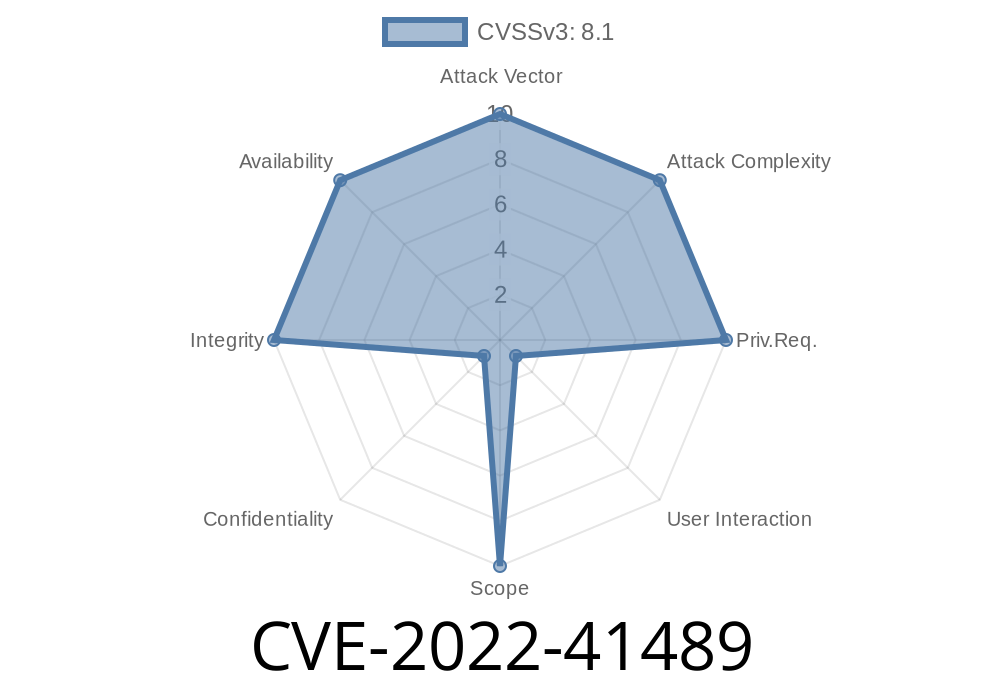A new vulnerability has been discovered in WAYOS LQ_09 22.03.17V, a widely-used network management software component. CVE-2022-41489 details a Cross-Site Request Forgery (CSRF) vulnerability present in the Usb_upload.htm component of the software. This vulnerability allows attackers to send malicious requests to the server from the affected device, potentially damaging systems by executing unauthenticated actions on behalf of targeted users.
In this post, we will explore the details of this vulnerability, show a code snippet that demonstrates the exploit, and provide resources to understand and mitigate this issue.
Exploit Details
The vulnerability is caused by a lack of proper authentication in the Usb_upload.htm component of WAYOS LQ_09 22.03.17V. No CSRF token is provided when users interact with the component, making it possible for attackers to forge malicious requests that appear authentic. When the server receives these requests, it processes them as legitimate actions, leading to harmful consequences for the user and possibly the entire network.
CVE-2022-41489 allows bad actors to perform various actions such as modify system settings, create unauthorized accounts, upload malicious software, or even reset the entire device to its factory settings.
The following snippet demonstrates how an attacker can exploit this vulnerability
<!DOCTYPE html>
<html>
<body>
<h1>Example of a malicious CSRF exploit on WAYOS LQ_09 22.03.17V</h1>
<form action="http://target-ip/Usb_upload.htm"; method="POST" enctype="multipart/form-data">
<input type="hidden" name="malicious_data" value="some_vulnerable_parameter" />
<input type="submit" value="Click me" />
</form>
</body>
</html>
When a user clicks the "Click me" button, their browser will send a crafted POST request to the target IP address, modifying the vulnerable parameter without their knowledge or explicit consent.
Original References
For an in-depth understanding of this vulnerability, the following resources provide valuable information:
1. CVE-2022-41489 Official Vulnerability Record: https://cve.mitre.org/cgi-bin/cvename.cgi?name=CVE-2022-41489
2. National Vulnerability Database (NVD) Entry: https://nvd.nist.gov/vuln/detail/CVE-2022-41489
3. OWASP CSRF Prevention Guide: https://cheatsheetseries.owasp.org/cheatsheets/Cross-Site_Request_Forgery_Prevention_Cheat_Sheet.html
Mitigation
To mitigate the risk associated with this vulnerability, it is crucial to add proper CSRF protection for the affected component. One of the most effective ways to do so is by using a CSRF token, a unique, unguessable value that securely authenticates requests made by the user. The token should be verified on the server-side each time a sensitive action is requested.
Developers should also adopt a secure development approach and follow best practices outlined by resources such as OWASP to ensure their applications are protected from similar vulnerabilities in the future.
Conclusion
CVE-2022-41489 is a critical CSRF vulnerability in WAYOS LQ_09 22.03.17V that has the potential to compromise systems through unauthorized actions. Understanding the exploit, reviewing the original references, and implementing proper mitigation strategies protect users and organizations from the risks associated with this vulnerability.
Timeline
Published on: 10/13/2022 14:15:00 UTC
Last modified on: 10/14/2022 14:37:00 UTC
